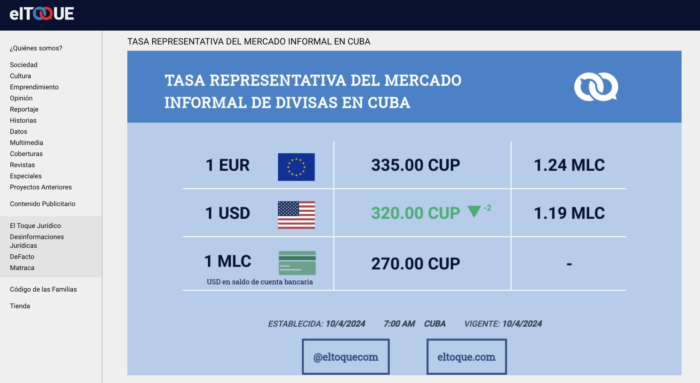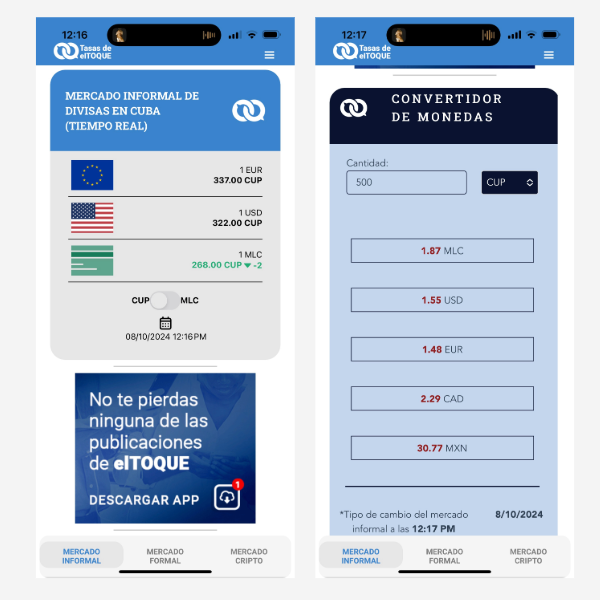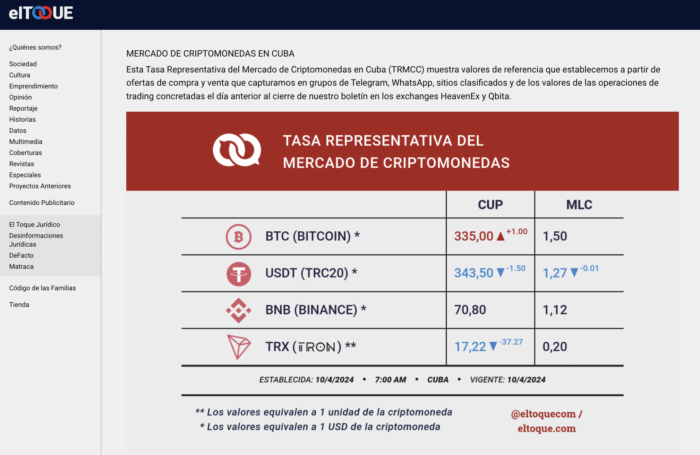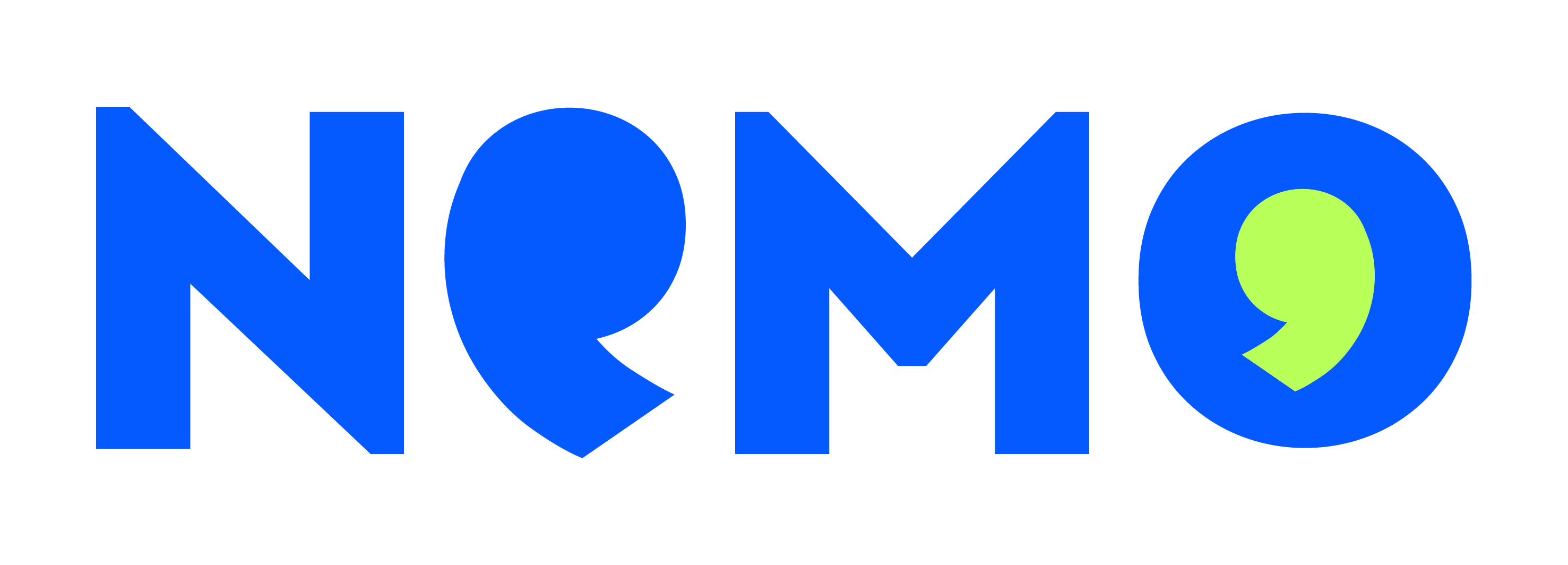By Andrew Deck
In Havana, a phrase is widely printed on restaurant menus and displayed by shop owners: “exchange rate of the day.” This daily rate is used to calculate prices for U.S. dollars or euros, which are frequently used instead of Cuban pesos given the country’s ongoing economic crisis.
What often goes unsaid is who, exactly, is calculating that rate. The Cuban government has, for years, fixed the Cuban peso to the U.S. dollar. This creates a schism between the official rate and the rate that foreign currencies actually sell for on the informal market. Rather than pulling up the anchored rate, most businesses instead show the AI-powered exchange rate published daily on El Toque, an independent digital news site run by Cuban journalists in exile.
“I was talking with a foreign diplomat in Havana who said, ‘I just arrived on the island, I took a taxi and I only had foreign currency. The prices were in pesos, so they showed me your website,’” said José Jasán Nieves Cárdenas, the editor-in-chief of El Toque, who leads the newsroom from Miami. Nieves said he often hears stories like this.
Founded in 2014, El Toque until recently was most known for its traditional news coverage, including accountability and opinion journalism on Cuban state policy and politics. When the site first launched its exchange rate dashboard in June 2021, fewer than 100,000 users were visiting its website every month. In 2022, as Cuba’s economic crisis worsened, traffic to the dashboard ballooned. Foreign news agencies, including Reuters, AFP, and the Spanish wire service EFE, began citing El Toque’s rates in their financial reporting. In October 2023, El Toque launched an accompanying mobile app with a built-in exchange calculator.
In May and June of this year, El Toque’s site topped 900,000 monthly users. As of this month, the mobile app has nearly 100,000 installations.

For years, Cuba has suffered food and medicine shortages, declining wages, and soaring inflation, among a host of other economic stressors. As a result, stable foreign currencies are essential to buying basic goods, keeping business operations afloat, and accessing money sent by family members working overseas.
To meet this demand, Cuban pesos, U.S. dollars, and euros are regularly bought and sold on informal digital marketplaces — private WhatsApp groups, Telegram channels, Facebook Messenger chats, and Cuban classifieds sites like Revolico. El Toque’s dashboard allows readers to make informed decisions while navigating this, at times, volatile black market.
“It’s data that if we don’t provide, no one is going to,” said Taylí Sánchez, a product manager at El Toque who has been working on the tool for the past two years. “It is data that is very important for their lives, for their businesses, for their every day.”
Part of El Toque’s innovation is using AI to generate its exchange rates. Back in 2021, the team custom-built scrapers to pull posts from these social media marketplaces. They also trained a natural language processing (NLP) tool to interpret the writing in these posts, extracting information about which currency is being bought or sold, how much of it, and at what rate. Using this information, their algorithm can remove outliers and calculate a median exchange rate.
When the tool first launched, El Toque’s staff used to manually publish the rate every morning at 7 a.m. They soon automated that process as well. Today, the data is automatically processed, cleaned, structured, and visualized as a graphic each morning to be shared on social media, and then updated throughout the day in real time on the website and app dashboard.

An important caveat is that El Toque’s scrapers can only track buying and selling offers. They can’t actually document the final transaction rates coming out of these groups. The figure is, therefore, what El Toque calls a “representative exchange rate.”
To build a theoretically sound tool, El Toque brought on economist Pavel Vidal Alejandro, who used to work on monetary policy at the Central Bank of Cuba and is now a professor at Pontificia Universidad Javeriana in Colombia. Vidal Alejandro sees the impact of the exchange tracker in more than its everyday use in cities like Havana. It also challenges the Cuban government’s monopoly on narratives about the ongoing economic crisis.
“Given the lack of transparency and infrequency in the publication of official economic statistics, El Toque’s rate fills this information gap,” said Vidal Alejandro. “The informal rate is a real-time thermometer of the economic crisis, inflation, lack of credibility, and failures of official economic policies.”
Recently, El Toque started offering access to its API, allowing services to build on top of real-time exchange rate data. Currently, more than 50 developers regularly access the API, including CiberCuba, one of the most-read digital news sites in the country. The site republishes El Toque’s figures daily. For now, Nieves says all API access is free, but they are closely monitoring its usage and may charge users if they begin earning significant revenue from their data.
In fact, El Toque currently receives no direct revenue from the currency exchange tracker, despite its widespread popularity.
“I do believe there’s an opportunity to monetize this solution, but in our main market, people that need this information, they don’t have the money to pay,” said Nieves. As he explains it, any paywall model would likely be prohibitively expensive.
“The only money we have been able to get is through grants that support the Cuban people’s access to free information,” he said. Currently, El Toque receives grant funding from international journalism organizations like Fondo Velocidad, Meedan, and the International Fact-Checking Network. “The transparency this service provides is something that helps us to make the case to donors that we’re providing critical information in a censored environment.”
Nieves has lived in exile since 2019 and says the increasingly hostile environment for independent journalists in Cuba has pushed most of his team to leave the country. In late 2022, a new law threatened journalists who receive funding from foreign organizations with up to 10 years in prison. State police have since targeted El Toque, making unsubstantiated claims that it is funded by the CIA and detaining journalists who they allege collaborate with the publication. Even from Miami, Nieves has faced continued threats to his safety.
Today, El Toque runs as a transnational newsroom, with journalists residing in 10 different countries, including Mexico, Spain, and Chile. A small number of journalists do clandestine reporting from the island. The distance of the product team from its audience has made maintaining and expanding El Toque’s exchange rate tools difficult.
“Many people in Cuba use the service, but they’re not able to talk about how they are using the service, and that adds another level of complexity,” said Sánchez. Her team has sent out anonymous surveys, monitored API usage, and closely tracked mobile app data as a substitute for these one-on-one conversations. “It is very challenging to build a product without that user voice.”
Still, user feedback did prompt El Toque to launch a companion cryptocurrency exchange tracker on its dashboard. It was also user feedback that pushed the team to ship its mobile app last year. In its first month, the app only saw 173 users per day, but this past June, it reached a new peak of 74,000 users per day.

More than any future revenue, Nieves says the exchange rate dashboard’s most important value to El Toque has been as a marketing campaign. The tool has widely bolstered the outlet’s name recognition across Cuba. If anything, the challenge is reminding users that El Toque also produces traditional news articles.
Sánchez says they are constantly trying to redirect users to the site’s daily coverage and accountability journalism. More than 93% of El Toque’s website traffic comes from mobile, so they are also building out article reading experiences into the mobile app to meet readers where they are.
The tool’s ubiquity has also put an even larger target on El Toque’s back. In May, government officials, including the prime minister, accused the outlet of using the exchange rates to sabotage the national economy on behalf of the U.S. government. Officials also claimed El Toque’s rates were untrustworthy, since they could be easily manipulated by posting fake social media offers to online marketplaces.
“This is part of a much broader confrontation by the Cuban government against independent media,” said Vidal Alejandro. “Blaming an external entity for economic failures fits well within the script the government has used for decades to evade responsibility.”
Following the government remarks, El Toque saw a wave of trolls enter informal marketplaces and post extreme buying and selling rates. Built into their system is unique user identification, which records the history of regular posters. El Toque’s algorithm puts a greater weight on users that have a consistent track record of buying and selling, and only registers one post per user every 24 hours. Nieves says guardrails like these have effectively filtered out attempts to corrupt El Toque’s data.
The government remarks posed a technical challenge, but they also had the potential to erode user trust. For now, Nieves says his team has maintained its user base, first and foremost, through transparency.
“We have been clear about our methodology since the beginning, and we haven’t changed our methodology, just added new layers of security … We even publish a list of the social media posts we [capture] every day,” said Nieves. El Toque regularly produces articles about its methods and explains notable fluctuations in its rates. An academic paper co-authored by Vidal Alejandro validating the economic theory behind the tool is currently under peer review.
“We are still here. We’ve survived that crisis,” Nieves said. “We still get testimonials of people using our rate despite the government’s attacks.”
____________________________________________________________________________________________
This story was originally published by Nieman Lab and has been featured in our blog with the appropiate permission.

